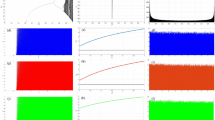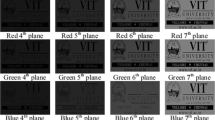Abstract
The advancement of multimedia and computer technology has facilitated increasing number of research on digital video watermarking. Video watermarking techniques can be used not only in the protection of multimedia video works’ copyright, but also in the transmission of confidential data. This paper presents a color video watermarking algorithm based on hyperchaotic Lorentz system. Firstly, the color watermark images are scrambled using hyperchaotic Lorentz system to enhance its confidentiality. Secondly, we use shot boundary detection to extract non-motion frames of the video. Then the chaotic sequence is used to determine the specific frames among the non-motion frames. Next, we apply the discrete wavelet transform to specific frames to get the appropriate subbands. And finally the encrypted watermarks are embedded into the selected subbands. The performance of proposed method is evaluated by Peak Signal-to-Noise Ratio, Normalized Correlation and Structural Similarity Index Measure. Experiments showed that the average PSNR and SSIM of watermarked frames are 57.00 dB and 0.99, respectively, which indicate that the proposed method has high imperceptibility. The NC value of 1.00 proves that the watermark can be transmitted without loss under no attacks. And we also tested the robustness and imperceptibility in the presence of various attacks including image processing attacks, geometrical attacks and video attacks. The method we proposed enrich the digital watermarking techniques.









Similar content being viewed by others
References
Agilandeeswar L, Ganesan K (2016) A bi-directional associative memory based multiple image watermarking on cover video. Multimed Tools Appl:7211–7256
Ali M, Ahn CW, Pant M (2014) A robust image watermarking technique using SVD and differential evolution in DCT domain. Optik:428–434
Ali M, Ahn W, Wook C (2014) An optimized watermarking technique based on self-adaptive DE in DWT–SVD transform domain. Signal Process:545–556
Boreczky JS, Rowe LA (1996) Comparison of video shot boundary detection techniques. Journal of Electronic Imaging:122–128
Caragata D, El Assad S, Luduena M (2015) An improved fragile watermarking algorithm for JPEG images. AEU-International Journal of Electronics and Communications:53–64
Carnec M, Le Callet P, Barba D (2008) Objective quality assessment of color images based on a generic perceptual reduced reference. Signal Processing-Image Communication:239–256
Chang CC, Hsiao JY, Chan CS (2003) Finding optimal least-significant-bit substitution in image hiding by dynamic programming strategy. Pattern Recogn:1583–1595
Cox IJ, Kilian J, Leighton FT et al (1997) Secure Spread Spectrum Watermarking for Multimedia. IEEE Trans Image Process:1673–1687
Dogan S (2016) A new data hiding method based on chaos embedded genetic algorithm for color image. Artif Intell Rev:129–143
Fridrich J, Goljan M, Du R (2002) Lossless data embedding-New paradigm in digital watermarking. Eurasip Journal on Applied Signal Processing:185–196
Hartung F, Girod B (1998) Watermarking of uncompressed and compressed video. Signal Process:283–301
Hartung F, Kutter M (1999) Multimedia watermarking techniques. Proc IEEE:1079–1107
Hsu CT, Wu JL (1998) DCT-based watermarking for video. IEEE Trans Consum Electron:206–216
Jiang TF (2015) Digital Watermarking Technology and Its Application, First edn. Science Press, Beijing
Jiang XM, Liu Q, Wu QY (2013) A new video watermarking algorithm based on shot segmentation and block classification. Multimed Tools Appl:545–560
Khan MK (2011) Research advances in data hiding for multimedia security. Multimed Tools Appl:257–261
Lai CC, Tsai CC (2010) Digital Image Watermarking Using Discrete Wavelet Transform and Singular Value Decomposition. IEEE Trans Instrum Meas:3060–3063
Liu XY, Li FF, Du JY et al (2017) A robust and synthesized-unseen watermarking for the DRM of DIBR-based 3D video. Neurocomputing:155–169
Liu JX, Wen XB, Yuan LM (2017) A robust approach of watermarking in contourlet domain based on probabilistic neural network. Multimed Tools Appl:24009–24026
Loan NA, Hurrah NN et al (2018) Secure and Robust Digital Image Watermarking Using Coefficient Differencing and Chaotic Encryption. IEEE ACCESS 6:19876–19897
Mehta R, Rajpal N, Vishwakarma VP (2016) LWT-QR decomposition based robust and efficient image watermarking scheme using Lagrangian SVR. Multimed Tools Appl:4129–4150
Mohammed AA, Ali NA (2018) Robust video watermarking scheme using high efficiency video coding attack. Multimed Tools Appl:2791–2806
Singh RP, Dabas N, Chaudhary V (2016) Online Sequential Extreme Learning Machine for watermarking in DWT domain. Neurocomputing:238–249
Song XH, Wang S, Ahmed A (2014) Dynamic watermarking scheme for quantum images based on Hadamard transform. Multimedia Systems:379–388
Sridhar B (2017) An investigation of different video watermarking techniques. International Journal on Smart Sensing and Intelligent Systems:387–406
Su QT (2015) Digital image blind watermarking technology. Tsinghua University Press, Beijing
Su QT, Wang G, Lv GH et al (2017) A novel blind color image watermarking based on Contourlet transform and Hessenberg decomposition. Multimed Tools Appl:8781–8801
Tang CW, Huang HM (2003) A feature-based robust digital image watermarking scheme. IEEE Trans Signal Process:950–959
Vaidya SP, Chandra Mouli PVSSR (2017) A robust semi-blind watermarking for color images based on multiple decompositions. Multimed Tools Appl:25623–25656
Wang Z, Bovik AC et al (2004) Image quality assessment: from error visibility to structural similarity. IEEE Trans Image Process:600–612
Wang W, Si MM, Pang Y, Ran P et al (2018) An encryption algorithm based on combined chaos in body area networks. Comput Electr Eng 65:282–291
Wang W, Tan HY, Sun P, Pang Y, Ren BB (2016) A novel digital image encryption algorithm based on wavelet transform and multi-chaos. Wireless Communication and Sensor Network:711–719
Wang XY, Wang MJ (2008) A hyperchaos generated from Lorenz system. Physica A-Statistical Mechanics and Its Applications:3751–3758
Zhang Y (2016) Chaotic Digital Image Cryptosystem, First ed. Tsinghua University Press, Beijing
Zhang F, Zhang HB (2005) Applications of a neural network to watermarking capacity of digital image. Neurocomputing:345–349
Zheng PP, Feng J, Li Z (2014) A novel SVD and LS-SVM combination algorithm for blind watermarking. Neurocomputing:520–528
Acknowledgments
The work is supported by National Natural Science Foundation of China (Grant Nos. 61571372, 61672436), Fundamental Research Funds for the Central Universities (Grant Nos. XDJK2016A001, XDJK2017A005) and Special key project of basic science and frontier technology research of Chongqing (Grant Nos. cstc2017jcyjBX0050).
Author information
Authors and Affiliations
Corresponding author
Additional information
Publisher’s note
Springer Nature remains neutral with regard to jurisdictional claims in published maps and institutional affiliations.
Rights and permissions
About this article
Cite this article
Cao, Z., Wang, L. A secure video watermarking technique based on hyperchaotic Lorentz system. Multimed Tools Appl 78, 26089–26109 (2019). https://doi.org/10.1007/s11042-019-07809-5
Received:
Revised:
Accepted:
Published:
Issue Date:
DOI: https://doi.org/10.1007/s11042-019-07809-5




